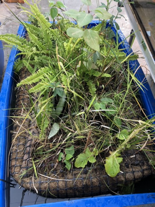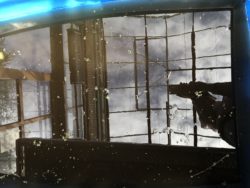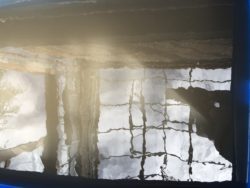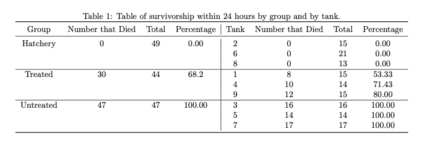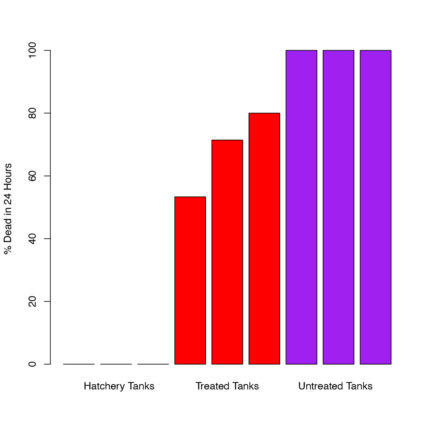by Lizbeth Seebacher, Research Scientist, University of Washington
Background
Salmon recovery through habitat restoration has been the focus of land managers since at least the 1990s. During effectiveness monitoring surveys, behavior of returning pre-spawn adult coho revealed water quality problems with surface swimming, gaping, fin splaying and loss of orientation and equilibrium. The affected fish died within hours and female carcasses showed high rates of egg retention. After many spawning seasons spent observing water quality conditions, the thing that stood out as responsible for mortality was rain events and urban watersheds. The mortality syndrome was prevented when highway run-off was pretreated with bio media.
Although the mortality syndrome is correlated with urbanization and attributed to road runoff, the causal agent(s) remain unknown. The Puget Sound Science Stormwater Team determined that tire wear particle (TWP) leachate provided the same lethal results, and they are zeroing in on the identity of the unknown contaminants in stormwater.
In the Puget Sound region, many highly urbanized areas cannot accommodate the addition of biofiltration swales or ponds to treat stormwater before it enters waterbodies. The high cost of land in these areas makes constructing stormwater wetlands prohibitively expensive, and many current designs allow water to bypass treatment during high flow rain events. In addition, stormwater pipes are often found in creeks and no one knows their point of origin. Together, these factors create a major hurdle to urban stream and lake pollution reduction efforts intended to reduce coho mortality.
We wanted to research using floating treatment wetlands (FTWs) in place of bio media in ponds or swales. The FTWs can also be used as a vehicle for bio media. This method can be used in streams in urban watersheds where placing bioswales is not feasible. We can place the FTW/bio media directly in the receiving waterbody at the location of stormwater entry to reduce contaminant load in stormwater, allowing survival of pre-spawn and juvenile coho and reducing the impacts of stormwater on other salmonids.
Methodology
With funding from the King County Council, stormwater from SR 520 was collected in the spring of 2019. The stormwater was moved to two 110-gallon tanks at the University of Washington. One of the tanks was “treated” for 24 hours with an FTW planted with species shown to have phytoremediative properties for elements found in stormwater, and bio media hanging underneath. The bio media consisted of 10% compost, 15% peat-moss, 20% sand, 25% alder wood crumbles and 30% wood mulch, as well as the coconut fiber in the FTW within which the plants are planted. Both emergent wetland species and native submerged species were used. The other tank was left untreated. After 24 hours, the stormwater was moved to 10-gallon tanks, with 3 replicates for each treatment: treated, untreated and control (hatchery water). Juvenile salmon were collected from the Tulalip tribal hatchery and exposed to the treated and untreated stormwater for 24 hours. The water quality was monitored every hour for temperature, DO, and pH. Fish survival and behavior was monitored every hour for treated, untreated and control tanks. The water from each tank was sent to AmTest to be tested for metals and other parameters.
Results
Statistical analysis of the survival data indicates that 0% of the fish died in the control tanks, 69% in the treated tanks, and 100% in the untreated tanks. The takeaway is that 31% survived the entire 24 hours in the treated water. The time to death was also statistically significant, using Kaplan–Meier estimator. In the untreated stormwater tanks, 70% of the fish were dead in the third hour and the remaining fish died during the fourth hour. Fish in treated water that did not survive the full 24 hours had a median time to death of 13 hours, much longer than the 3 hours for fish in untreated water. When evaluating the differences in metals found in the water quality samples, there is a clear trend for many metals tested; treated water showed a reduction in antimony, chromium, molybdenum and copper.
While future studies are planned, it appears that “treating” urban stormwater with FTW planted with appropriate species and bio media can improve water quality and reduce the presence of contaminants. These findings show promise for improving conditions for coho survival in areas where it is not possible to construct swales or stormwater ponds.
The next phases of the project will include improving the bio media further, finding the best phytoremediative species for western Washington, and designs for field application.

